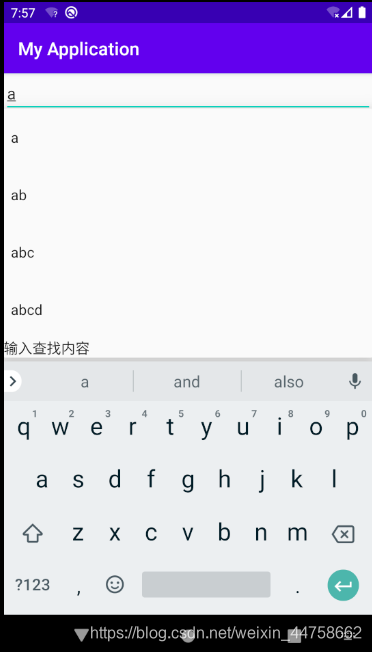在Android的开发中,用户界面的设计尤其重要,基本的一些组件非常简单,只要有过了解加上操作,就能熟练的运用,但是高级的组件还需要温故知新、查漏补缺。下面是我总结的属性及使用详例,快快收藏叭!
高级UI对应属性大全及使用详例
AutoCompleteTextView
AutoCompleteTextView用于输入一定字符后显示下拉列表框,供用户进行选择
| XML属性 | 功能 |
|---|---|
| android:completionHint | 设置文本框中的提示信息 |
| android:dropDownHeight | 设置提示框的高度单位dp |
| android:dropDownWidth | 设置提示框的宽度单位dp |
| android:popuPBackground | 为提示框设置背景 |
| android:completionThreshold | 设置输入几个字符串才会显示提示信息 |
| 其他 | 其他属性不常用,使用默认设置的就好 |
下面看看详例:

MXL文件布局:
<AutoCompleteTextView
android:id="@+id/comtv"
android:layout_weight="7"
android:layout_width="wrap_content"
android:layout_height="wrap_content"
android:completionHint="输入查找内容"
android:completionThreshold="1"
/>
Activity类代码,主要是为 AutoCompleteTextView配置一个适配器,具体请看代码:
import androidx.appcompat.app.AppCompatActivity;
import android.os.Bundle;
import android.widget.ArrayAdapter;
import android.widget.AutoCompleteTextView;
public class MainActivity extends AppCompatActivity {
private String[] str={"a","ab","abc","abcd"};
AutoCompleteTextView autoCompleteTextView;
@Override
protected void onCreate(Bundle savedInstanceState) {
super.onCreate(savedInstanceState);
setContentView(R.layout.activity_main);
autoCompleteTextView=findViewById(R.id.comtv); //获取自动完成文本框
ArrayAdapter arrayAdapter=new ArrayAdapter(this,android.R.layout.simple_dropdown_item_1line,str); //创建适配器
autoCompleteTextView.setAdapter(arrayAdapter); //加入适配器
}
}
ProgressBar
ProgressBar就是我们常用的进度条
| XML属性 | 功能 |
|---|---|
| 可用 style | 设置进度条样式 |
| android:max | 设置进度条最大值 |
| android:progress | 设置进度条当前进度 |
| android:progressDrawable | 设置进度条轨道的绘制形式 |
style
| XML属性 | 功能 |
|---|---|
| ?android:attr/progressBarStyleHorizontal | 细长条进度条 |
| ?android:attr/progressBarStyleLarge | 大圆形进度条 |
| ?android:attr/progressBarStyleSmall | 小圆形进度条 |
| @android:style/Widget.ProgressBar.Horizontal | 粗长条进度条 |
| @android:style/Widget.ProgressBar.Large | 大跳跃旋转的进度条 |
| @android:style/Widget.ProgressBar.Small | 大跳跃旋转的进度条 |

发挥进度条真正的作用,还需配合进程Thread和Handler使用,以更新进度条,起到提示作用。
添加圆形的进度条
<ProgressBar
android:id="@+id/pbar"
style="?android:attr/progressBarStyleLarge"
android:layout_width="match_parent"
android:layout_height="wrap_content"
/>
MainActivity代码
import android.os.Bundle;
import android.os.Handler;
import android.os.Message;
import android.view.View;
import android.widget.ProgressBar;
import android.widget.Toast;
import androidx.annotation.NonNull;
import androidx.appcompat.app.AppCompatActivity;
/**********************配合进程Thread和Handler对进度条进行更新**********************************************/
public class MainActivity extends AppCompatActivity {
int m=0;
ProgressBar pbar;
private Handler handler;
@Override
protected void onCreate(Bundle savedInstanceState) {
super.onCreate(savedInstanceState);
setContentView(R.layout.activity_main);
pbar=findViewById(R.id.pbar);
handler=new Handler(){
@Override
public void handleMessage(@NonNull Message msg) {
if (msg.what==0x1121) //0x1121,等于为其命名
// 假如为水平进度条,应在if下为其设置新进度,但我选择的是圆形加载进度条,不用为其设置新进度,
Toast.makeText(MainActivity.this,"加载中...",Toast.LENGTH_SHORT).show();
else{
Toast.makeText(MainActivity.this,"加载完成",Toast.LENGTH_LONG).show();
pbar.setVisibility(View.GONE);//关闭进度条释放内存
}
}
};
new Thread(new Runnable() {
@Override
public void run() {
while (true){
Message message=new Message();
m+= (int) (Math.random()*10); //生成10内的随机数,模拟一个耗时操作
if (m<100) {
try {
Thread.sleep(1000); //为体现效果,让线程休眠1秒
} catch (InterruptedException e) {
e.printStackTrace();
}
message.what=0x1121;
handler.sendMessage(message); //发送信息
}
else {
try {
Thread.sleep(1000); //为体现效果,让线程休眠1秒
} catch (InterruptedException e) {
e.printStackTrace();
}
message.what=0x110;
handler.sendMessage(message);
break;
}
}
}
}).start();
}
}
SeekBar
SeekBar是拖动条,用户可以进行拖动,用来改变某种数值
为其设置监听后并重写方法
3种常用方法如下
import android.os.Bundle;
import android.widget.SeekBar;
import androidx.appcompat.app.AppCompatActivity;
public class MainActivity extends AppCompatActivity {
SeekBar seekBar;
@Override
protected void onCreate(Bundle savedInstanceState) {
super.onCreate(savedInstanceState);
setContentView(R.layout.activity_main);
seekBar=(SeekBar) findViewById(R.id.seek);
seekBar.setOnSeekBarChangeListener(new SeekBar.OnSeekBarChangeListener() {
@Override
public void onProgressChanged(SeekBar seekBar, int i, boolean b) { //进度改变时执行的方法,i为当前进度值
}
@Override
public void onStartTrackingTouch(SeekBar seekBar) { //拖动开始时的方法
}
@Override
public void onStopTrackingTouch(SeekBar seekBar) { //拖动结束时的方法
}
});
}
}
RatingBar
RatingBar是星状的评分条,如淘宝的评价等
扫描二维码关注公众号,回复:
11430396 查看本文章


| XML属性 | 功能 |
|---|---|
| android:rating | 设置默认选择的星星数 |
| android:numStars | 设置评分条总星数 |
| android:stepSize | 设置评分条最少改变的星星数 |
| android:isIndicator | 设置评分条是否能改变,true为不能 |
下面是RatingBar的常用方法与实例

XML代码
<RatingBar
android:id="@+id/rating"
android:layout_width="wrap_content"
android:layout_height="wrap_content"
android:numStars="5"
android:rating="5"
android:stepSize="1"
/>
<Button
android:id="@+id/button1"
android:layout_width="wrap_content"
android:layout_height="wrap_content"
android:text="确定"
android:background="@color/colorAccent"
/>
MainActivity中主要代码:
import android.os.Bundle;
import android.util.Log;
import android.view.View;
import android.widget.Button;
import android.widget.RatingBar;
import androidx.appcompat.app.AppCompatActivity;
public class MainActivity extends AppCompatActivity {
RatingBar rating1;
Button button;
@Override
protected void onCreate(Bundle savedInstanceState) {
super.onCreate(savedInstanceState);
setContentView(R.layout.activity_main);
rating1=findViewById(R.id.rating);
button=findViewById(R.id.button1);
button.setOnClickListener(new View.OnClickListener() {
@Override
public void onClick(View view) {
int a=rating1.getProgress();//获取进度,为getRating()与getStepSize()的乘积
float b=rating1.getRating();//获取获得的星数
float c=rating1.getStepSize();//获取每次要改变的星数
float d=rating1.getNumStars();//获取总星数
Log.i("RatingBar", "进度为:"+a+",获得的星数为:"+b+",每次要改变的星数为:"+c+",评分条总星数为:"+d);
}
});
}
}
TabHost
实现图:

实现步骤
1、在布局文件中添加TabHost、TabWidget、FrameLayout组件(注意:TabHost、TabWidget、FrameLayout的id需要用系统指定的)
2、编写要显示的xml文件
3、在Activity中初始化TabHost并添加标签页
布局文件代码:
<?xml version="1.0" encoding="utf-8"?>
<TabHost xmlns:android="http://schemas.android.com/apk/res/android"
xmlns:tools="http://schemas.android.com/tools"
android:id="@android:id/tabhost"
android:layout_width="match_parent"
android:layout_height="wrap_content"
tools:context=".MainActivity">
<LinearLayout
android:orientation="vertical"
android:layout_width="match_parent"
android:layout_height="match_parent">
<TabWidget
android:id="@android:id/tabs"
android:layout_width="match_parent"
android:layout_height="match_parent"/>
<FrameLayout
android:id="@android:id/tabcontent"
android:layout_width="match_parent"
android:layout_height="match_parent"/>
</LinearLayout>
</TabHost>
MainActivity中的代码:
import android.os.Bundle;
import android.view.LayoutInflater;
import android.widget.TabHost;
import androidx.appcompat.app.AppCompatActivity;
public class MainActivity extends AppCompatActivity {
TabHost tabHost;
@Override
protected void onCreate(Bundle savedInstanceState) {
super.onCreate(savedInstanceState);
setContentView(R.layout.activity_main);
tabHost=findViewById(android.R.id.tabhost);
tabHost.setup(); //初始化Tabhost
LayoutInflater inflater= LayoutInflater.from(this); //该对象用于加载标签页
inflater.inflate(R.layout.contacts,tabHost.getTabContentView());
inflater.inflate(R.layout.news,tabHost.getTabContentView());
tabHost.addTab(tabHost.newTabSpec("news").setIndicator("消息").setContent(R.id.new_1)); //添加标签页 setContent(R.id.new_1)为布局文件的id
tabHost.addTab(tabHost.newTabSpec("contacts").setIndicator("联系人").setContent(R.id.contacts_1));
}
}